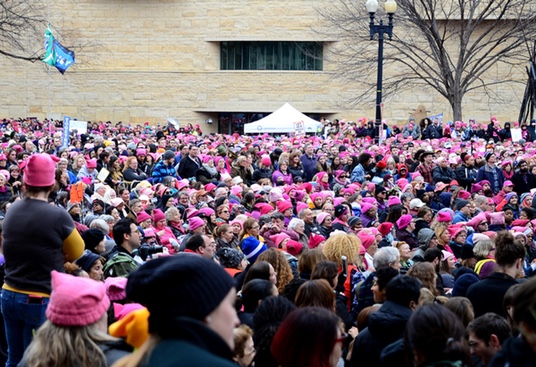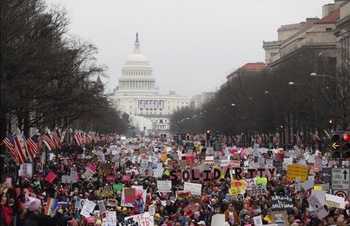
When my husband said, “Your father would want you to march,” I knew he was right, and I reserved a seat to fly to Washington for the Women’s March. The Women’s March on Washington was promoted as an event to show solidarity for women’s rights, and it quickly expanded into a march for equality. I marched to protect the rights of women, people of color, the religious faithful, the LGBT community, and the poor and disenfranchised. The Women’s March was not meant to be a divisive event, but one to unify Americans.
The day of the presidential inauguration, while sitting at the Cleveland Hopkins gate, I saw my first of many crocheted Pussyhat Project hats. On the plane, impassioned women quickly became involved in lively conversations and shared the most recent Washington news. I ordered a bourbon and never paid for it — only later did I realize that it wasn’t the flight attendant’s oversight. At Dulles, I easily and without incident found the Silver Line bus ticket counter that would take me to the Metro Station and the Silver Line train into D.C. People were happy to help the wave of women descending on the nation’s capital and make sure we were comfortable.
It felt like a movement.

As I write about this, a week after my trip to Washington, I am still trying to digest what it means to resist and what it is we’re resisting. That it IS a movement brings tears to my eyes. Everything I feared might happen this week has, with the swift signing of executive orders that were aligned with the new administration’s agenda. Even though nothing was surprising, I’m shocked by the suppression of the media and scientists, and by the President’s refusal to release his tax returns and divest his assets. It is a time of great fear amongst citizens who believe we are a nation that supports democracy, freedom of speech, and a safe haven for immigrants.
What was it like to be at the Women’s March? I settled into a spot on a north-south street with my daughter and her friends, where we could see and hear the rally on a screen with speakers. People jostled us as they looked for friends and tried to get to the port-a-potties. The crowds became so dense where we standing that we couldn’t move and were literally holding each other up with our bodies. If anyone fell, we would all fall, and when ambulances came down the street, which happened four times, we had to tiptoe our ways backward so we didn’t step on the toes of those behind us.
The people were jubilant and unified and respectful and glad to be part of what turned out to be a great day. For four hours, we watched the rally on the screen. Organizers, politicians, celebrities, and organization leaders spoke, read poetry and played music to strengthen us. Participants raised homemade signs with slogans such as “Love Trumps Hate,” “Embrace Diversity,” and “Strength in Numbers.” Everyone had their reasons for being there, reasons as diverse as black lives matter, a woman’s right to choose, freedom of religion, and upholding of Christian values. It was clear that the crowd was speaking out against a political climate that divides us and threatens our freedom and welfare.
We almost didn’t march. At 2pm, with the rally coming to an end and marchers stiff from standing so long in one place, we were told to disperse because the masses were too large. We stood there in disbelief. A few minutes later we were asked to turn and march north from wherever we were. Faces around me lit up in smiles and people cheered as we walked slowly north. We sang “This Little Light of Mine” and chanted “Love is what it’s all about.”
Children marched with their parents who sometimes carried infants, and seniors pushed through the crowds with oxygen and walkers. I overheard parents explaining to their children what was going on, and the children listening with great reverence. Two 65-year-old men in tie-dyed shirts commented that the crowd was larger than the one during the 1968 March on Washington. It was the sort of experience where you are right in the moment, and for me, it was profound to see so many people in one place, breathing and moving together, supporting each other and believing that we the people should make our voices heard.
As a marcher, it was difficult to see how big we were. Every so often, a young person would climb up on someone’s shoulders to report on what they could see. It was a wall of people. One six-year-old girl said “Wow” with such an awestruck look on her face that many of us who witnessed it laughed with jubilation.

We wove through packed sidewalks back to the home we were staying at in a D.C. neighborhood. Once there, we turned on the television and, to our surprise, we saw demonstrations all over the United States and the world. We learned that the march in which we’d just participated was the largest single-day demonstration in U.S. history, with over 500,000 people participating. The worldwide participation is believed to be around five million, with at least 400 marches in the United States and around 673 total marches on all seven continents of the world.
Amazingly, the marches were peaceful. That’s because this movement is about love and respect for all.
Following the march, the organizers of the Women’s March on Washington posted the “10 Actions for the first 100 Days” campaign for activism to keep up the momentum ignited by the march. Go to womensmarch to get started.
Claudia Taller is a Cleveland writer, yoga instructor, igniter of possibilities. Her father was a Methodist minister who preached for equality and peace during the 1960s, a time of civil unrest in the United States.
One Response to “CoolCleveland’s Claudia Taller Shares Her Thoughts About the Women’s March in D.C.”
Tim
An enlightening and well written article about the march. I know some people who went to the Cleveland march and was told it was life-changing. A thoughtful, non-preachy view of the event. Well done!